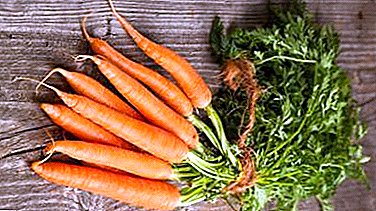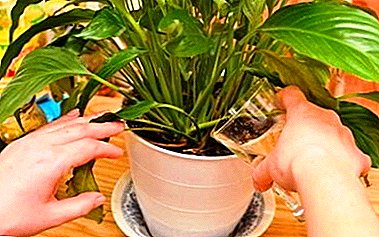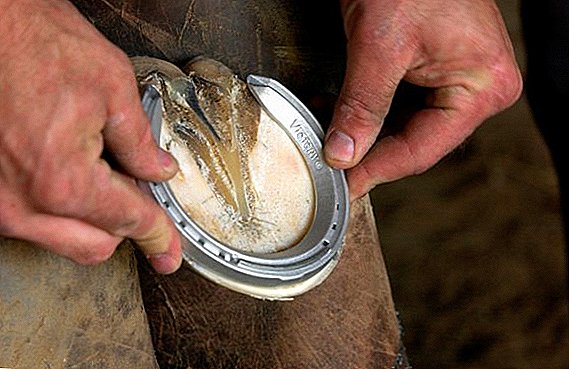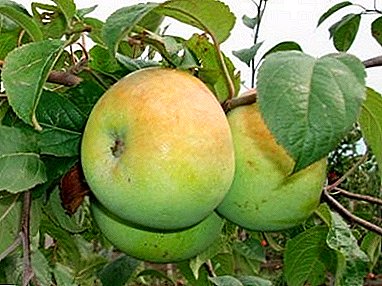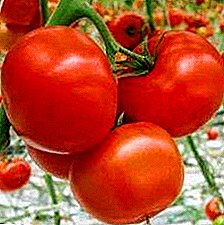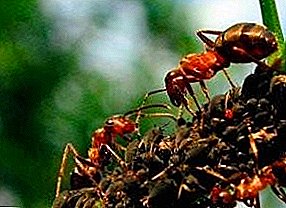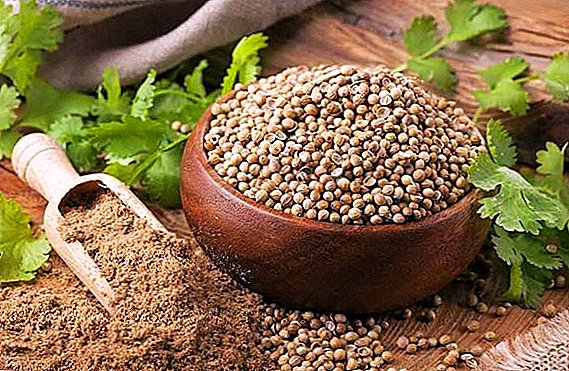 Without various spices it is difficult to imagine many dishes, however, few people know that some of them are successfully used for medical or cosmetic purposes. Coriander is just such a spice, the chemical composition and useful properties of which made it an excellent component of various popular recipes. What kind of plant is it, what does it taste like and how best to use it for different purposes - read on.
Without various spices it is difficult to imagine many dishes, however, few people know that some of them are successfully used for medical or cosmetic purposes. Coriander is just such a spice, the chemical composition and useful properties of which made it an excellent component of various popular recipes. What kind of plant is it, what does it taste like and how best to use it for different purposes - read on.
What is coriander and how it looks
Sowing or vegetable coriander is an annual herbaceous plant type, which belongs to the Umbrella family. The strong smell of seeds of culture has become one of the main reasons for its popularization in the culinary field and perfumery, but the aroma of the above-ground green part (fresh cilantro), on the contrary, can push the gardener away. With age, the plant it is significantly weaker, but you can get rid of it only in the process of drying the collected vegetation. 
The height of vegetable coriander reaches 70 cm, and you can recognize it by curly leaves, something like parsley leaves. Flowers - pinkish or white color, small size, after their flowering fruits are formed with seeds.
All of them are presented in the form of ribbed whiskers and, in fact, are called coriander. It turns out that cilantro and coriander are one and the same plant, only in the first case we are talking about the green part of the crop, and in the second about fruits with seeds, often used in cooking and alternative medicine. In cosmetology and perfumery, all parts of the culture have been used.
Important! The rate of consumption of fresh cilantro per adult per day is not more than 35 g, while the number of seeds or roots consumed should not exceed 3-4 g.
Useful properties of coriander
Coriander seeds are distinguished by a multifaceted pharmacological effect, which explains the high efficiency of the plant in various areas of human activity.
The main medicinal properties are expressed in its following abilities:
- normalization of the digestive organs working capacity due to improvement of appetite, effective removal of gases accumulated in the intestine, stabilization of production and output of bile, easy laxative action;
- elimination of hemorrhoids and associated discomfort;
- sputum liquefaction (especially important for dry cough and bronchitis);
- antiseptic and wound healing effects;
- anti-inflammatory and antiviral effects;
- removal of toxins, removal of unpleasant symptoms of heartburn;
- decrease in body temperature, decrease of burning sensation during inflammation of the skin;
- beneficial effects on the kidneys and urinary system, both for women and men;
- uniform distribution of body fat, which is appropriate in the complex treatment of obesity.

Chemical composition of seasoning
Most varieties of coriander contain a large amount of essential oils, protein compounds, starch and sterols.
In addition, they also contain:
- vitamins A, PP, C, groups B (B1 and B2);
- the minerals calcium, magnesium, sodium, phosphorus, iodine and iron;
- alkaloids;
- Sahara;
- polyphenols;
- organic acids;
- tannins;
- rutin;
- carotene.
In addition, mature coriander fruits contain 0.7-1.4% of essential oils, which also have a number of useful components.
Did you know? Russia ranks first on the list of global exporters of coriander. According to approximate estimates, in 2018 more than 30 thousand tons of this spice was exported from the country.
How to use coriander
Coriander is used for culinary, medical and cosmetic purposes, both in grains and in ground form, however, wherever you use it, it is important to know about the rules for preparing and consuming raw materials.
In folk medicine
In the recipes of alternative medicine, the most popular options are juice, decoction and oil from a plant, on the basis of which it is much easier to prepare healing remedies. Whole fruits can be used in the manufacture of fees to normalize the health of the stomach and optimize the process of choleretic. The powder of them is suitable for the preparation of laxatives and anti-hemorrhoids infusions, perfectly combining with the flowers of immortelle and mint leaves.  Coriander oil is often included in the composition of wound healing and anti-inflammatory ointments or prepared on the basis of their special drops and lotions. Cilantro is a good raw material for formulations of antihelminthic, analgesic and carminative action, but it is recommended to dry the herbs before preparing the medicine.
Coriander oil is often included in the composition of wound healing and anti-inflammatory ointments or prepared on the basis of their special drops and lotions. Cilantro is a good raw material for formulations of antihelminthic, analgesic and carminative action, but it is recommended to dry the herbs before preparing the medicine.
In combination with honey, infusion of seeds can be used to normalize the emotional and mental state of a person, saving him from hysteria and increased anxiety. Of course, with a serious problem, some folk remedies will not be enough, but in combination with drug therapy, the beneficial effects of coriander cannot be denied.
We advise you to read about the difference between cilantro and coriander.
In cosmetology
As in other areas of human activity, there are a lot of options for the use of coriander in cosmetology. Seeds are often included in the composition of tonics and lotions to rejuvenate and maintain the natural beauty of the skin of the face, and also used in the preparation of healing masks for weak or greasy hair. 
In the latter case, this ingredient is particularly useful, because not only normalizes the activity of the sebaceous glands, but also eliminates dandruff. Masks with coriander well nourish and strengthen damaged hair, from the roots to the tips.
If desired, on the basis of grains or leaves, you can prepare a skin care product for the whole body, which will help to even out its tone and get rid of blemishes. For the face, a good solution to this issue will be a tonic from the leaves of the plant, which need to wipe the skin twice a day: morning and evening.
Important! When using coriander leaves, one should not forget about a large amount of essential oils in their composition. If they are mixed improperly with water and other ingredients, they can cause skin burns, so before using the prepared product it is recommended to check its effect on the crook of the elbow.
Separately, it is worth noting the successful use of coriander essential oils in the perfume industry and aromatherapy, which at home perfectly removes signs of fatigue, helps to restore the body after suffering viral ailments and colds. For a treatment session, it is enough to drop a few drops of the substance into the aroma lamp or prepare a bath with the addition of an oily product.
In cooking
Coriander (plant seeds) is more often used for culinary purposes, and salads are prepared from the green part or leaves are added to soups.

As a spice, the spice will be appropriate in the following cases:
- when stewing cabbage and cooking on its basis;
- when creating the first dishes on the basis of legumes (lentils and beans);
- for flavoring pickled vegetables, fish (for example, herring or sprat);
- when creating desserts, combining coriander seeds with sugar or honey;
- for preparation of preparations for the winter (adjika, satsibeli, tkemali or cornel sauces).
In addition, coriander is one of the main spices of ready-made spices, such as curry seasoning (approximately 20-30% of the total), Mexican mole, or Georgian hop-suneli seasoning.
Learn also about the differences between cumin and coriander.
What spice add more
In addition to the usual recipes for the use of coriander, there are not quite standard options for its use. So, in some countries, spice is included in the composition of liqueurs and some other alcoholic beverages, as well as preparing hot and cold coffee.
Often, coriander seeds are added to pastries (cookies or gingerbread), they sprinkle bakery products, and they also combine well with pumpkin and beet dishes, can be used in the production of sausage, canned fish and vegetables. Perhaps a combination of spices with other spices, but the most successful union of coriander - with cumin.

The green part of the plant has been used for domestic purposes, which is largely due to its strong odor. The fact is that such vegetation perfectly repels rodents, therefore, it is laid out in attics and in other places of a possible aggregation of animals. Seeds do not have such bright properties, but they can be poured into a cloth bag and put in a closet with clothes to scare away moths.
How to store coriander
Coriander belongs to the vegetation, which even after drying does not lose its aromatic properties, on the contrary, they change in a more attractive direction. To achieve maximum disclosure of all the characteristics of the fruit, it is desirable to keep them whole, grinding immediately before use.
Did you know? 100 g of coriander contains 225% of the daily value of vitamin A and 258% of vitamin K, which help strengthen the skeletal system and maintain the health of the mucous membranes and skin. At the same time, the caloric content of the seeds is insignificant - not more than 25 kcal.
With cilantro, everything is a bit more complicated, because the greens are not capable of keeping their original properties and appearance for a long time. In the absence of suitable conditions, the leaf plates quickly fade, so save them in the refrigerator for more than a week will not work. In room conditions and without water, the shelf life is even shorter and is only 2-4 days.
In order to preserve the benefits of greenery and its flavor for a long time, you will have to use freezing or drying before washed, dried and chopped cilantro. It is most convenient to store it in separate sealed bags. If desired, you can store greens and sprigs, without cutting, but in this case, they still break, and you get the same chopped greens.

Contraindications and harm
Contraindications coriander relevant as with its use as a seasoning, and when used for medical purposes, because, one way or another, he is capable of harming such illnesses:
- ischemic heart disease and myocardial infarction;
- renal diseases;
- hypertension and thrombophlebitis;
- gastritis and gastric ulcer, with all associated conditions;
- diabetes;
- open and bleeding wounds.
We advise you to read more about the composition and properties of cilantro.
With the uncontrolled use of spices or exceeding the recommended prescription dosage, the appearance of adverse reactions may occur. The most frequent violations in this case are sleep disturbances, malfunctions in the digestive system, various allergic reactions, and malfunctions in the male and female reproductive systems (for example, violation of the menstruation cycle), although the latter is quite rare.
If you comply with all the requirements for the preparation and use of spices, none of the above should not disturb you and the application of the described plant will bring only a positive result associated with the maximum disclosure of all its functions.




